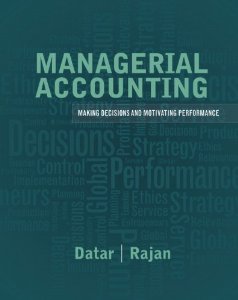This is completed downloadable of Test Bank for Managerial Accounting Making Decisions and Motivating Performance 1st Edition Datar

Product Details:
- ISBN-10 : 0137024878
- ISBN-13 : 978-0137024872
- Author:
Managerial Accounting: Making Decisions and Motivating Performance enables managers and business owners to attain the core skills they need to become integral members of their company’s decision-making teams.
This new program from established authors Srikant M. Datar and Madhav Rajan emphasizes decision-making and the effects of decisions. While many texts teach the theories and frameworks of management education, Managerial Accounting goes further by covering the capabilities and techniques necessary for effective management practice, as well as fostering attitudes that typify integrity, honesty, and fairness.
Table of Content:
- 1 The Manager and Management Accounting
- Learning Objectives
- Financial Accounting and Management Accounting
- Strategic Decisions and the Management Accountant
- Value-Chain and Supply-Chain Analysis and Key Success Factors
- Value-Chain Analysis
- Supply-Chain Analysis
- Key Success Factors
- Sustainability
- Decision Making, Planning, and Control
- Key Management Accounting Guidelines
- Cost–Benefit Approach
- Behavioral and Technical Considerations
- Different Costs for Different Purposes
- Organization Structure and the Management Accountant
- Line and Staff Relationships
- The Chief Financial Officer and the Controller
- Management Accounting Beyond the Numbers2
- Professional Ethics
- Institutional Support
- Typical Ethical Challenges
- Problem for Self-Study
- Required
- Solution
- Decision Points
- Terms to Learn
- Assignment Material
- Questions
- Exercises
- Required
- Required
- Required
- Required
- Required
- Required
- Required
- Required
- Required
- Problems
- Required
- Decisions
- Required
- Decisions
- Required
- Required
- Required
- Required
- Required
- Required
- 2 An Introduction to Cost Terms and Purposes
- Learning Objectives
- Costs and Cost Terminology
- Direct Costs and Indirect Costs
- Challenges in Cost Allocation
- Factors Affecting Direct/Indirect Cost Classifications
- Cost-Behavior Patterns: Variable Costs and Fixed Costs
- Cost Drivers
- Relevant Range
- Relationships of Types of Costs
- Total Costs and Unit Costs
- Unit Costs
- Use Unit Costs Cautiously
- Business Sectors, Types of Inventory, Inventoriable Costs, and Period Costs
- Manufacturing-, Merchandising-, and Service-Sector Companies
- Types of Inventory
- Commonly Used Classifications of Manufacturing Costs
- Inventoriable Costs
- Period Costs
- Illustrating the Flow of Inventoriable Costs and Period Costs
- Manufacturing-Sector Example
- Recap of Inventoriable Costs and Period Costs
- Prime Costs and Conversion Costs
- Measuring Costs Requires Judgment
- Measuring Labor Costs
- Overtime Premium and Idle Time
- Benefits of Defining Accounting Terms
- Different Meanings of Product Costs
- A Framework for Cost Accounting and Cost Management
- Calculating the Cost of Products, Services, and Other Cost Objects
- Analyzing the Relevant Information for Making Decisions
- Obtaining Information for Planning and Control and Performance Evaluation
- Problem for Self-Study
- Required
- Solution
- Decision Points
- Appendix
- Variable Costing and Absorption Costing
- Undesirable Buildup of Inventories
- Proposals for Revising Performance Evaluation
- Variable Costing
- Comparing Income Statements
- Comparing Absorption Costing and Variable Costing
- Terms to Learn
- Assignment Material
- Questions
- Exercises
- Required
- Required
- Required
- Required
- Required
- Required
- Required
- Required
- Required
- Required
- Required
- Required
- Required
- Problems
- Required
- Required
- Required
- Required
- Required
- Required
- Required
- Required
- Required
- Required
- Required
- Required
- Required
- Required
- 3 Cost–Volume–Profit Analysis
- Learning Objectives
- Essentials of CVP Analysis
- Contribution Margin
- Expressing CVP Relationships
- Equation Method
- Contribution Margin Method
- Graph Method
- Cost–Volume–Profit Assumptions
- Breakeven Point and Target Operating Income
- Breakeven Point
- Target Operating Income
- Target Net Income and Income Taxes
- Using CVP Analysis for Decision Making
- Decision to Advertise
- Decision to Reduce Selling Price
- Determining Target Prices
- Sensitivity Analysis and Margin of Safety
- Cost Planning and CVP
- Alternative Fixed-Cost/Variable-Cost Structures
- Operating Leverage
- Effects of Sales Mix on Income
- CVP Analysis in Service and Not-for-Profit Organizations
- Contribution Margin Versus Gross Margin
- Problem for Self-Study
- Required
- Solution
- Decision Points
- Appendix
- Decision Models and Uncertainty1
- Role of a Decision Model
- Expected Value
- Good Decisions and Good Outcomes
- Terms to Learn
- Assignment Material
- Questions
- Exercises
- Required
- Required
- Required
- Required
- Required
- Required
- Required
- Required
- Required
- Required
- Required
- Required
- Problems
- Required
- Required
- Required
- Required
- Required
- Required
- Required
- Required
- Required
- Required
- Required
- Required
- Required
- Required
- 4 Job Costing
- Learning Objectives
- Building-Block Concepts of Costing Systems
- Job-Costing and Process-Costing Systems
- Job Costing: Evaluation and Implementation
- Time Period Used to Compute Indirect-Cost Rates
- Normal Costing
- General Approach to Job Costing Using Normal Costing
- The Role of Technology
- Actual Costing
- A Normal Job-Costing System in Manufacturing
- General Ledger
- Explanations of Transactions
- Nonmanufacturing Costs and Job Costing
- Budgeted Indirect Costs and End-of-Accounting-Year Adjustments
- Underallocated and Overallocated Indirect Costs
- Adjusted Allocation-Rate Approach
- Proration Approach
- Writeoff to Cost of Goods Sold Approach
- Choice Among Approaches
- Variations from Normal Costing: A Service-Sector Example
- Problem for Self-Study Required
- Required
- Solution
- Decision Points
- Appendix
- Allocating Costs with Multiple Overhead Cost Pools
- Direct Method
- Step-Down Method
- Reciprocal Method
- Overview of Methods
- Calculating the Cost of Job WPP 298
- Terms to Learn
- Assignment Material
- Questions
- Exercises
- Required
- Required
- Required
- Required
- Required
- Required
- Required
- Required
- Required
- Required
- Required
- Required
- Required
- Problems
- Required
- Required
- Required
- Required
- Required
- Required
- Required
- Required
- 5 Process Costing and Cost Allocation
- Learning Objectives
- Illustrating Process Costing
- Case 1: Process Costing with No Beginning or Ending Work-in-Process Inventory
- Case 2: Process Costing with Zero Beginning and Some Ending Work-in-Process Inventory
- Physical Units and Equivalent Units (Steps 1 and 2)
- Calculation of Product Costs (Steps 3, 4, and 5)
- T-Account Entries
- Case 3: Process Costing with Some Beginning and Some Ending Work-in-Process Inventory
- Weighted-Average Method
- First-In, First-Out Method
- Comparison of Weighted-Average and FIFO Methods
- Using Budgeted Rates
- Hybrid-Costing Systems
- Overview of Operation-Costing Systems
- Illustration of an Operation-Costing System
- T-Account Entries
- Cost Allocation for Joint Costs and Common Costs
- Allocating Joint Costs
- Allocating Common Costs
- Stand-Alone Cost-Allocation Method
- Incremental Cost-Allocation Method
- Problem for Self-Study
- Required
- Solution
- Decision Points
- Terms to Learn
- Assignment Material
- Questions
- Exercises
- Required
- Required
- Required
- Required
- Required
- Required
- Required
- Required
- Required
- Required
- Required
- Required
- Required
- Required
- Problems
- Required
- Required
- Required
- Required
- Required
- Required
- Required
- Required
- Required
- Required
- Required
- Required
- Required
- 6 Activity-Based Costing and Activity-Based Management
- Learning Objectives
- Broad Averaging and Its Consequences
- Undercosting and Overcosting
- Product-Cost Cross-Subsidization
- Simple Costing System at Plastim Corporation
- Design, Manufacturing, and Distribution Processes
- Simple Costing System Using a Single Indirect-Cost Pool
- Applying the Five-Step Decision-Making Process at Plastim
- Refining a Costing System
- Reasons for Refining a Costing System
- Guidelines for Refining a Costing System
- Activity-Based Costing Systems
- Plastim’s ABC System
- Cost Hierarchies
- Implementing Activity-Based Costing
- Implementing ABC at Plastim
- Comparing Alternative Costing Systems
- Considerations in Implementing Activity-Based Costing Systems
- Benefits and Costs of Activity-Based Costing Systems
- Behavioral Issues in Implementing Activity-Based Costing Systems
- Activity-Based Management
- Pricing and Product-Mix Decisions
- Cost Reduction and Process Improvement Decisions
- Design Decisions
- Planning and Managing Activities
- ABC in Service and Merchandising Companies
- Problem for Self-Study
- Required
- Solution
- Decision Points
- Terms to Learn
- Assignment Material
- Questions
- Exercises
- Required
- Required
- Required
- Required
- Required
- Required
- Required
- Required
- Required
- Required
- Required
- Required
- Required
- Problems
- Required
- Required
- Required
- Required
- Required
- Required
- Required
- Required
- Required
- Required
- Required
- Required
- Required
- Required
- 7 Pricing Decisions, Customer Profitability, and Cost Management
- Learning Objectives
- Major Factors that Affect Pricing Decisions
- Customers
- Competitors
- Costs
- Weighing Customers, Competitors, and Costs
- Costing and Pricing for the Long Run
- Calculating Product Costs for Long-Run Pricing Decisions
- Alternative Long-Run Pricing Approaches
- Target Costing for Target Pricing
- Understanding Customers’ Perceived Value
- Doing Competitor Analysis
- Implementing Target Pricing and Target Costing
- Value Engineering, Cost Incurrence, and Locked-In Costs
- Value-Chain Analysis and Cross-Functional Teams
- Achieving the Target Cost per Unit for Provalue
- Cost-Plus Pricing
- Cost-Plus Target Rate of Return on Investment
- Alternative Cost-Plus Methods
- Cost-Plus Pricing and Target Pricing
- Customer-Profitability Analysis
- Customer-Revenue Analysis
- Customer-Cost Analysis
- Customer-Level Costs
- Customer Profitability Profiles
- Presenting Profitability Analysis
- Cost Hierarchy-Based Operating Income Statement
- Using the Five-Step Decision-Making Process to Manage Customer Profitability
- Life-Cycle Product Budgeting and Costing
- Life-Cycle Budgeting and Pricing Decisions
- Customer Life-Cycle Costing
- Additional Considerations for Pricing Decisions
- Price Discrimination
- Peak-Load Pricing
- International Pricing
- Antitrust Laws
- Predatory Pricing
- Dumping
- Collusive Pricing
- Problem for Self-Study
- Required
- Solution
- Decision Points
- Terms to Learn
- Assignment Material
- Questions
- Exercises
- Required
- Required
- Required
- Required
- Required
- Required
- Required
- Required
- Required
- Required
- Required
- Problems
- Required
- Required
- Required
- Required
- Required
- Required
- Required
- Required
- Required
- Required
- Required
- Required
- Required
- Required
- 8 Determining How Costs Behave
- Learning Objectives
- Basic Assumptions of Linear Cost Functions
- Basic Assumptions
- Linear Cost Functions
- Nonlinear Cost Functions and Cost Classifications
- Learning Curves
- Review of Cost Classification
- Choice of Cost Object
- Time Horizon
- Relevant Range
- Identifying Cost Drivers
- The Cause-and-Effect Criterion
- Cost Drivers and the Decision-Making Process
- Cost Estimation Methods
- Industrial Engineering Method
- Conference Method
- Account Analysis Method
- Quantitative Analysis Method
- Steps in Estimating a Cost Function Using Quantitative Analysis
- High–Low Method
- Regression Analysis Method
- Evaluating Cost Drivers of the Estimated Cost Function
- Choosing Among Cost Drivers
- Cost Drivers and the Environment
- Cost Drivers and Activity-Based Costing
- Data Collection and Adjustment Issues
- Problem for Self-Study
- Required
- Solution
- Decision Points
- Terms to Learn
- Assignment Material
- Questions
- Exercises
- Required
- Required
- Required
- Required
- Required
- Required
- Required
- Required
- Required
- Required
- Required
- Required
- Required
- Problems
- Required
- Required
- Required
- Required
- Required
- Required
- Required
- Required
- Required
- 9 Decision Making and Relevant Information
- Learning Objectives
- Information and the Decision Process
- The Concept of Relevance
- Relevant Costs and Relevant Revenues
- Qualitative and Quantitative Relevant Information
- One-Time-Only Special Orders
- Potential Problems in Relevant-Cost Analysis
- Short-Run Pricing Decisions
- Relevant Costs for Short-Run Pricing Decisions
- Strategic and Other Factors in Short-Run Pricing
- Insourcing-Versus-Outsourcing and Make-or-Buy Decisions
- Outsourcing and Idle Facilities
- Strategic and Qualitative Factors
- International Outsourcing
- The Total Alternatives Approach
- The Opportunity-Cost Approach
- Carrying Costs of Inventory
- Product-Mix Decisions with Capacity Constraints
- Theory of Constraints and Throughput-Margin Analysis
- Customer Profitability, Activity-Based Costing, and Relevant Costs
- Relevant-Revenue and Relevant-Cost Analysis of Dropping a Customer
- Relevant-Revenue and Relevant-Cost Analysis of Adding a Customer
- Relevant-Revenue and Relevant-Cost Analysis of Closing or Adding Branch Offices or Segments
- Irrelevance of Past Costs and Equipment-Replacement Decisions
- Decisions and Performance Evaluation
- Irrelevance of Joint Costs for Decision Making
- Joint-Cost Allocation and Performance Evaluation
- Problem for Self-Study
- Required
- Solution
- Decision Points
- Appendix
- Linear Programming
- Steps in Solving an LP Problem
- Trial-and-Error Approach
- Graphic Approach
- Sensitivity Analysis
- Terms to Learn
- Assignment Material
- Questions
- Exercises
- Required
- Required
- Required
- Required
- Required
- Required
- Required
- Required
- Required
- Required
- Required
- Problems
- Required
- Required
- Required
- Required
- Required
- Required
- Required
- Required
- Required
- Required
- Required
- Required
- Required
- Required
- Required
- 10 Quality, Inventory Management, and Time
- Learning Objectives
- Quality as a Competitive Tool
- The Financial Perspective: Costs of Quality
- Using Nonfinancial Measures to Evaluate and Improve Quality
- The Customer Perspective: Nonfinancial Measures of Customer Satisfaction
- The Internal-Business-Process Perspective: Analyzing Quality Problems and Improving Quality
- Control Charts
- Pareto Diagrams
- Cause-and-Effect Diagrams
- Six Sigma Quality
- Nonfinancial Measures of Internal-Business-Process Quality
- Quality Training and Quality Improvement Measures
- Making Decisions and Evaluating Quality Performance
- Relevant Costs and Benefits of Quality Improvement
- Inventory Management
- Economic-Order-Quantity Decision Model
- When to Order, Assuming Certainty
- Safety Stock
- Estimating Inventory-Related Relevant Costs and Their Effects
- Conflict Between the EOQ Decision Model and Managers’ Performance Evaluation
- Just-in-Time Purchasing
- JIT Purchasing and EOQ Model Parameters
- Relevant Costs of JIT Purchasing
- Supplier Evaluation and Relevant Costs of Quality and Timely Deliveries
- Inventory Management, MRP, and JIT Production
- Materials Requirements Planning
- Just-in-Time (JIT) Production
- Features of JIT Production Systems
- Financial Benefits of JIT and Relevant Costs
- Enterprise Resource Planning (ERP) Systems4
- Performance Measures and Control in JIT Production
- Effect of JIT Systems on Product Costing
- Lean Accounting
- JIT Systems and Supply-Chain Analysis in Retailing
- JIT in Service Industries
- Time as a Competitive Tool
- Customer-Response Time and On-Time Performance
- Bottlenecks and Time Drivers
- Relevant Revenues and Relevant Costs of Time
- Time-Related Measures
- Problem for Self-Study
- Required
- Solution
- Decision Points
- Terms to Learn
- Assignment Material
- Questions
- Exercises
- Required
- Required
- Required
- Required
- Required
- Required
- Required
- Required
- Required
- Required
- Required
- Required
- Required
- Problems
- Required
- Required
- Required
- Required
- Required
- Required
- Required
- Required
- Required
- Required
- Required
- Required
- Required
- Required
- Required
- 11 Capital Investments
- Learning Objectives
- Stages of Capital Budgeting
- Discounted Cash Flow
- Net Present Value Method
- Internal Rate-of-Return Method
- Comparison of Net Present Value and Internal Rate-of-Return Methods
- Sensitivity Analysis
- Payback Method
- Uniform Cash Flows
- Nonuniform Cash Flows
- Accrual Accounting Rate-of-Return Method
- Relevant Cash Flows in Discounted Cash Flow Analysis
- Relevant After-Tax Flows
- Categories of Cash Flows
- Project Management and Performance Evaluation
- Postinvestment Audits
- Performance Evaluation
- Strategic Considerations in Capital Budgeting
- Investment in Research and Development
- Customer Value and Capital Budgeting
- Problem for Self-Study
- Part A
- Required
- Solution
- Part B
- Solution
- Decision Points
- Appendix
- Capital Budgeting and Inflation
- Net Present Value Method and Inflation
- Terms to Learn
- Assignment Material
- Questions
- Exercises
- Required
- Required
- Required
- Required
- Required
- Required
- Required
- Required
- Required
- Required
- Required
- Problems
- Required
- Required
- Required
- Required
- Required
- Required
- Required
- Required
- Required
- Required
- Required
- Answers to Exercises in Compound Interest (Exercise 11-11)
- 12 Master Budget and Responsibility Accounting
- Learning Objectives
- Budgets and the Budgeting Cycle
- Strategic Plans and Operating Plans
- Budgeting Cycle and Master Budget
- Advantages of Budgets
- Coordination and Communication
- Framework for Judging Performance and Facilitating Learning
- Motivate Managers and Other Employees
- Challenges in Administering Budgets
- Developing an Operating Budget
- Time Coverage of Budgets
- Steps in Preparing an Operating Budget
- Financial Planning Models and Sensitivity Analysis
- Budgeting and Responsibility Accounting
- Organization Structure and Responsibility
- Feedback
- Responsibility and Controllability
- Human Aspects of Budgeting
- Budgetary Slack
- Stretch Targets
- Ethics
- Kaizen Budgeting
- Budgeting in Multinational Companies
- Problem for Self-Study
- Required
- Solution
- Decision Points
- Appendix
- The Cash Budget
- Preparation of Budgets
- Sensitivity Analysis and Cash Flows
- Terms to Learn
- Assignment Material
- Questions
- Exercises
- Required
- Required
- Required
- Required
- Required
- Required
- Required
- Required
- Required
- Required
- Required
- Required
- Problems
- Required
- Required
- Required
- Required
- Required
- Required
- Required
- Required
- Required
- Required
- Required
- Required
- Required
- Required
- 13 Flexible Budgets, Cost Variances, and Management Control
- Learning Objectives
- Static Budgets and Variances
- The Use of Variances
- Static Budgets and Static-Budget Variances
- Flexible Budgets
- Sales-Volume Variances
- Flexible-Budget Variances
- Price Variances and Efficiency Variances for Direct-Cost Inputs
- Obtaining Budgeted Input Prices and Budgeted Input Quantities
- Data for Calculating Webb’s Price Variances and Efficiency Variances
- Price Variances
- Efficiency Variance
- Planning Overhead Costs and Calculating Overhead Rates
- Planning Variable Overhead Costs
- Planning Fixed Overhead Costs
- Standard Costing
- Developing Budgeted Variable Overhead Rates
- Developing Budgeted Fixed Overhead Rates
- Variable Overhead Cost Variances
- Flexible-Budget Analysis
- Variable Overhead Efficiency Variance
- Variable Overhead Spending Variance
- Fixed Overhead Cost Variances
- Production-Volume Variance
- Interpreting the Production-Volume Variance
- Integrated Analysis of Variances
- Summary of Variances
- How Managers Use Variances
- Multiple Causes of Variances
- When to Investigate Variances
- Performance Measurement Using Variances
- Organization Learning
- Continuous Improvement
- Financial and Nonfinancial Performance Measures
- Cost Variances in Nonmanufacturing Settings
- Impact of Information Technology on Variances
- Problem for Self-Study
- Required
- Solution
- Decision Points
- Terms to Learn
- Assignment Material
- Questions
- Exercises
- Required
- Required
- Required
- Required
- Required
- Required
- Required
- Required
- Required
- Required
- Required
- Required
- Required
- Required
- Required
- Required
- Required
- Problems
- Required
- Required
- Required
- Required
- Required
- Required
- Required
- Required
- Required
- Required
- Required
- 14 Strategy, Balanced Scorecard, and Strategic Profitability Analysis
- Learning Objectives
- What Is Strategy?
- Building Internal Capabilities: Quality Improvement and Reengineering at Chipset
- Strategy Implementation and the Balanced Scorecard
- The Balanced Scorecard
- Strategy Maps and the Balanced Scorecard
- Strategy Maps
- Four Perspectives of the Balanced Scorecard
- Implementing a Balanced Scorecard
- Different Strategies Lead to Different Scorecards
- Features of a Good Balanced Scorecard
- Pitfalls in Implementing a Balanced Scorecard
- Evaluating the Success of Strategy and Implementation
- Strategic Analysis of Operating Income
- Growth Component of Change in Operating Income
- Revenue Effect of Growth
- Cost Effect of Growth
- Price-Recovery Component of Change in Operating Income
- Revenue Effect of Price Recovery
- Cost Effect of Price Recovery
- Productivity Component of Change in Operating Income
- Further Analysis of Growth, Price-Recovery, and Productivity Components
- Applying the Five-Step Decision-Making Framework to Strategy
- Downsizing and the Management of Processing Capacity
- Engineered and Discretionary Costs
- Identifying Unused Capacity for Engineered and Discretionary Overhead Costs
- Managing Unused Capacity
- Problem for Self-Study
- Required
- Solution
- Growth Component of Operating Income Change
- Price-Recovery Component of Operating-Income Change
- Productivity Component of Operating-Income Change
- Decision Points
- Terms to Learn
- Assignment Material
- Questions
- Exercises
- Required
- Required
- Required
- Required
- Required
- Required
- Required
- Required
- Required
- Required
- Required
- Required
- Required
- Problems
- Required
- Required
- Required
- Required
- Required
- Required
- Required
- Required
- Required
- Required
- 15 Transfer Pricing
- Learning Objectives
- Management Control Systems
- Formal and Informal Systems
- Effective Management Control
- Decentralization
- Benefits of Decentralization
- Costs of Decentralization
- Comparison of Benefits and Costs
- Decentralization in Multinational Companies
- Choices About Responsibility Centers
- Transfer Pricing
- Criteria for Evaluating Transfer Prices
- Calculating Transfer Prices
- An Illustration of Transfer Pricing
- Market-Based Transfer Prices
- Perfectly Competitive Market
- Distress Prices
- Imperfect Competition
- Cost-Based Transfer Prices
- Full-Cost Bases
- Variable-Cost Bases
- Hybrid Transfer Prices
- Prorating the Difference Between Maximum and Minimum Transfer Prices
- Negotiated Pricing
- Dual Pricing
- A General Guideline for Transfer-Pricing Situations
- Multinational Transfer Pricing and Tax Considerations
- Transfer Pricing for Tax Minimization
- Transfer Prices Designed for Multiple Objectives
- Additional Issues in Transfer Pricing: Tariffs and Customs Duties
- Problem for Self-Study
- Required
- Solution
- Decision Points
- Terms to Learn
- Assignment Material
- Questions
- Exercises
- Required
- Required
- Required
- Required
- Required
- Required
- Required
- Required
- Required
- Required
- Required
- Required
- Required
- Problems
- Required
- Required
- Required
- Required
- Required
- Required
- Required
- Required
- Required
- Required
- Required
- 16 Performance Measurement and Compensation
- Learning Objectives
- Financial and Nonfinancial Performance Measures
- Accounting-Based Measures for Business Units
- Return on Investment
- Residual Income
- Economic Value Added2
- Return on Sales
- Comparing Performance Measures
- Choosing the Details of the Performance Measures
- Alternative Time Horizons
- Alternative Definitions of Investment
- Alternative Asset Measurements
- Current Cost
- Long-Term Assets
- Target Levels of Performance and Feedback
- Choosing Target Levels of Performance
- Choosing the Timing of Feedback
- Performance Measurement in Multinational Companies
- Calculating the Foreign Division’s ROI in the Foreign Currency
- Calculating the Foreign Division’s ROI in U.S. Dollars
- Distinction Between Managers and Organization Units9
- The Basic Tradeoff: Creating Incentives versus Imposing Risk
- Intensity of Incentives and Financial and Nonfinancial Measurements
- Benchmarks and Relative Performance Evaluation
- Performance Measures at the Individual Activity Level
- Performing Multiple Tasks
- Team-Based Compensation Arrangements
- Executive Performance Measures and Compensation
- Strategy and Levers of Control13
- Boundary Systems
- Belief Systems
- Interactive Control Systems
- Problem for Self-Study
- Required
- Solution
- Decision Points
- Terms to Learn
- Assignment Material
- Questions
- Exercises
- Required
- Required
- Required
- Required
- Required
- Required
- Required
- Required
- Required
- Required
- Required
- Problems
- Required
- Required
- Required
- Required
- Required
- Required
- Required
- Required
- Required
- Required
- Required
- Appendix
- A Notes on Compound Interest and Interest Tables
- Interest Tables
- Table 1—Future Amount of $1
- Table 2—Present Value of $1
- Table 3—Amount of Annuity of $1
- Table 4—Present Value of an Ordinary Annuity of $1
- Field-Based Assignments and Experiential Learning
- Introduction
- Basic Preparation and General Tips for Obtaining Information
- Phase I Understanding the Context
- Text Chapters: 1, 2, and 3
- Key Objectives
- Potential Tasks
- Preparation
- Sources of Information
- Phase II Collecting and Developing Cost Information
- Text Chapters: 4, 5, 6, and 7
- Key Objectives
- Potential Tasks
- Preparation
- Sources of Information
- Phase III Cost Information for Decision Making
- Text Chapters: 8, 9, 10, and 11
- Key Objectives
- Potential Tasks
- Preparation
- Sources of Information
- Phase IV Analysis of Strategic Costs and Management Control (all aspects may not be feasible)
- Text Chapters: 12, 13, 14, 15, and 16
- Key Objectives
- Potential Tasks
- Preparation
- Sources of Information
- Glossary
- Index Author
- A
- B
- C
- D
- E
- F
- G
- H
- I
- J
- K
- L
- M
- N
- O
- P
- R
- S
- T
- V
- W
- Y
- Company
- A
- B
- C
- D
- E
- F
- G
- H
- I
- J
- K
- L
- M
- N
- O
- P
- Q
- R
- S
- T
- U
- V
- W
- X
- Y
- Z
- Subject
- A
- B
- C
- D
- E
- F
- G
- H
- I
- J
- K
- L
- M
- N
- O
- P
- Q
- R
- S
- T
- U
- V
- W
- X
- Y
- For Instructors
- For Students





